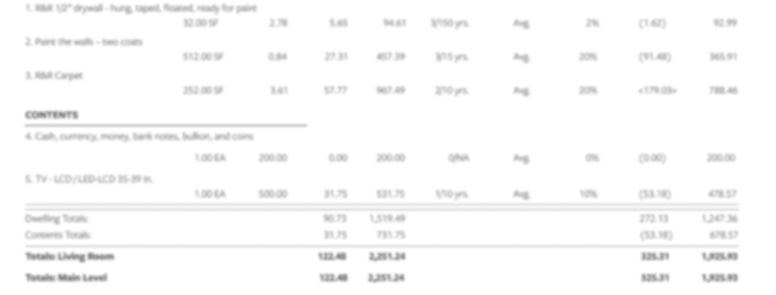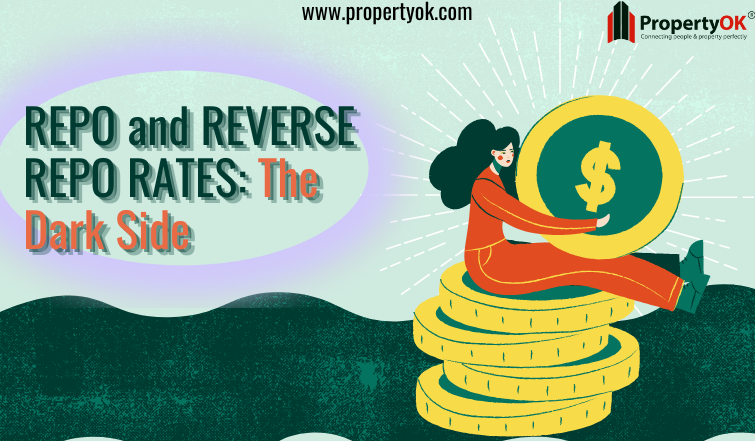Have you ever heard of repo and reverse repo rate? If not, you’re not alone. Despite their importance in the financial world, these often-overlooked interest rates can majorly impact the economy. However, they can also hinder economic growth when used improperly or excessively.
In this blog post, we’ll explore the dark side of repo and reverse repo rate and how they could hold back our global economy from reaching its full potential. So buckle up and get ready to dive into some complex financial concepts – because understanding these rates is crucial if we want to strengthen our economies for years to come!
Join our exclusive community: Gain access to the best properties and investment opportunities in Mumbai by joining our community of real estate experts.

Definition of Repo Rate and Reverse Repo Rate
In India, the repo rate is the rate at which the Reserve Bank of India (RBI) lends money to commercial banks. The reverse repo rate is the rate at which commercial banks lend money to the RBI. Both repo and reverse repo transactions are conducted through the RBI’s LAF (Liquidity Adjustment Facility). The LAF is used to regulate the money supply in the economy. It does this by injecting or sucking out liquidity as needed. The repo rate is currently set at 6.50%, and the reverse repo rate is set at 3.35%.
The RBI uses the repo rate to control inflation. When inflation is high, the RBI raises the repo rate, making borrowing more expensive for commercial banks. This encourages them to pass on the higher cost of borrowing to their customers, thereby cooling down demand and bringing down prices. Similarly, when inflation is low, the RBI cuts the repo rate to make borrowing cheaper for banks. This encourages them to lend more money, increasing demand and increasing prices.
Also Read:
THE LEGALITIES OF A RELEASE DEED: WHAT YOU NEED TO KNOW BEFORE SIGNING IN INDIA
The RBI also uses the repo rate to manage liquidity in the banking system. When there is too much money chasing too few goods, banks tend to lend recklessly, increasing bad loans. To suck out excess liquidity from the system and prevent this from happening, the RBI raises the repo rate. Conversely, when there is a shortage of funds in the system, banks
How do repo and reverse repo rates affect economic growth?
In simple terms, repo and reverse repo rate are the interest rates at which the central bank of a country ( Reserve Bank of India, in our case) lends money to commercial banks. The RBI uses these rates as a monetary policy tool to control inflation and spur economic growth. A higher repo rate makes it more expensive for banks to borrow money from the RBI, while a lower repo rate does the opposite.
The problem is that it hits economic growth when repo rates go up. That’s because higher borrowing costs make it more difficult for companies to expand and invest. As a result, GDP growth slows down. The same is true in reverse – when repo rates fall, it boosts economic activity, and growth picks up.
So how do we strike a balance? How do we ensure that repo rates are high enough to keep inflation in check but not so high that they start choking off economic growth?
It’s a tough tightrope to walk and one that the RBI has been struggling with in recent years. In 2018, for instance, the RBI raised the repo rate six times to control inflation. But this had the unintended consequence of slowing down economic growth, which fell from 7.2% in 2017-18 to 6.8% in 2018-19.
The moral is that raising or lowering repo rates is not a decision that should be taken lightly. It can have far-reaching implications for the economy,
Effect of Repo Rate Hike in Real Estate Sector
When the Reserve Bank of India (RBI) increases the repo rate, it becomes more expensive for banks to borrow money from the RBI. As a result, banks will increase their lending rates to account for the higher cost of borrowing. This, in turn, will lead to an increase in EMIs for home loan borrowers. A hike in repo rates usually has a direct and immediate impact on home loan interest rates. Therefore, raising the repo rate indirectly affects real estate prices when the RBI raises the repo rate.
A rise in interest rates makes investment in real estate less attractive, likely to result in a fall in demand for property. This could decrease prices or cause them to rise slower than expected. So, if you’re planning to buy a property, waiting until interest rates come down again makes sense.
Read More:
DON’T MAKE A MISTAKE: KNOW WHAT CIRCLE RATE IS BEFORE YOU BUY PROPERTY
Current Repo Rate in India
The repo rate in India is currently at 6.50%, down from the high of 8.00% in early 2018. The Indian repo rate is the rate at which the Reserve Bank of India (RBI) lends money to commercial banks. A lower repo rate means that banks can borrow money from the RBI at a lower interest rate, meaning they can lend money to customers at a lower interest rate.
While a lower repo rate is generally seen as good for the economy, as it can boost economic growth, some downside risks are also associated with it. One of these risks is that a lower repo rate can lead to inflationary pressures in the economy.
When commercial banks can borrow money from the RBI at a cheaper rate, they may be tempted to pass on this benefit to their customers by lending money out at a higher interest rate than what they would normally charge. This could increase the prices of goods and services and result in inflationary pressures in the economy.
Another risk associated with a lower repo rate is that it could encourage reckless borrowing by commercial banks. If commercial banks know they can borrow money cheaply from the RBI, they may be tempted to take on more loans than they can handle, eventually leading to financial instability.
Read More:
THE DANGERS OF IGNORING A CONVEYANCE DEED AND WHAT TO DO NEXT
The dark side of Repo and Reverse Repo Rate
The repo rate is the interest rate banks charge each other for overnight loans. The lower the repo rate, the less expensive it is for banks to borrow money from each other. This encourages banks to lend more money to businesses and consumers, which can help spur economic growth.
However, there is a downside to lowering the repo rate. When the repo rate is low, it can discourage lending and economic growth. That’s because when the repo rate is low, banks can earn more revenue by simply holding onto their cash rather than lending it out.
The calculation of Repo Rate by the Reserve Bank of India
As the Reserve Bank of India (RBI) is the central bank of India, it is responsible for maintaining price stability and ensuring the smooth functioning of the financial system in the country. The RBI uses many monetary policy tools to do this, including changing the repo and reverse repo rate.
The repo rate is the rate at which commercial banks can borrow money from the RBI for short-term purposes, while the reverse repo rate is when commercial banks can park their surplus funds with the RBI for short-term purposes.
If the RBI wants to increase liquidity in the banking system, it will reduce the repo rate. This will make borrowing from the RBI cheaper for commercial banks and encourage them to lend more money to businesses and consumers, thereby boosting economic growth.
On the other hand, if the RBI wants to tighten liquidity in the banking system, it will increase the repo rate. This will make borrowing from the RBI more expensive for commercial banks and discourage them from lending money, slowing economic growth.
Learn More:
LEASE AGREEMENT: A RECIPE FOR DISASTER OR A SAFE BET?
Distinction Between Repo Rate and Reverse Repo Rate
There is often confusion between the repo and reverse repo rate. Both are monetary policy tools the central bank uses to control liquidity in the banking system and, as a result, inflation. The main difference between the two rates is that the repo rate is the rate at which the central bank lends money to commercial banks, while the other rate is the rate at which commercial banks lend money to the central bank.
The repo rate controls inflation by making it more expensive for banks to borrow money. This leads to less lending by banks and, as a result, less money in circulation. This reduces demand and puts downward pressure on prices. The reverse repo rate works oppositely – it makes it cheaper for banks to borrow money from the central bank. This encourages more lending by banks and, as a result, more money in circulation. This increases demand and puts upward pressure on prices.
The central bank uses repo and reverse repo rate as tools to manage liquidity in the banking system and achieve its inflation target. If inflation is too high, the central bank will increase the repo rate (making it more expensive for banks to borrow money) in order to reduce money supply growth. Alternatively, if inflation is too low, the central bank will cut the repo rate (making it cheaper for banks to borrow money) to expand money supply growth.
Explore More:
WHY COMPLETION CERTIFICATE CAN BE MORE HARMFUL THAN HELPFUL IN REAL ESTATE IN INDIA
Conclusion
In conclusion, repo and reverse repo rate are important tools for achieving macroeconomic objectives such as controlling inflation, but their misuse can have severe consequences. When used excessively or when mismanaged, these rates can cause a liquidity crisis that may lead to slower economic growth and even recession. As such, central banks must understand the implications of these rates on economic activity before deciding on their course of action.
With adequate management and proper consideration for the longer-term effects on the economy, repo and reverse repo rate can be powerful instruments for maintaining financial stability.
Frequently Asked Questions:
1. How Does Repo Rate Work?
The repo rate is the rate at which the RBI (Reserve Bank of India) lends money to commercial banks. It is an important tool the RBI uses to manage liquidity and regulate inflation in an economy. When the repo rate increases, borrowing from RBI becomes more expensive and vice-versa. The higher repo rate reduces the money supply in the economy, leading to a fall in demand for goods and services and, thus, slowing down economic growth.
On the other hand, when the repo rate is lowered, more money is circulated in the economy, leading to increased demand for goods & services, resulting in economic growth. Therefore, investors and entrepreneurs must understand how repo rates affect their financial decisions.
2. What is the current repo rate in India?
The current repo rate in India is 6.50%. This is the rate at which the Reserve Bank of India (RBI) lends to commercial banks, and it is an important tool for controlling inflation and economic growth. While this rate might seem low, it can greatly impact financial markets, businesses, and the middle class. Therefore, it’s important to stay informed of RBI repo rates so that you can make informed financial decisions.
3. What is the relation between repo rate and reverse repo rate?
Repo rate and reverse repo rate are closely related to each other. The repo rate is the amount of money the central bank will lend to banks at a particular interest rate. In contrast, the reverse repo rate is the money banks can deposit with the central bank at a particular interest rate.

 Thank You
Thank You




